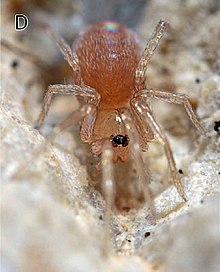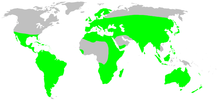| Goblin spiders Temporal range:
| |
|---|---|

| |
| Tapinesthis inermis, female | |
| Scientific classification | |
| Domain: | Eukaryota |
| Kingdom: | Animalia |
| Phylum: | Arthropoda |
| Subphylum: | Chelicerata |
| Class: | Arachnida |
| Order: | Araneae |
| Infraorder: | Araneomorphae |
| Family: | Oonopidae Simon, 1890 |
| Diversity | |
| 115 genera, 1874 species | |

| |
Oonopidae, also known as goblin spiders, is a family of spiders consisting of over 1,600 described species in about 113 genera worldwide,[1] with total species diversity estimated at 2000 to 2500 species.[2] The type genus of the family is Oonops Keyserling, 1835.
Goblin spiders are generally tiny, measuring about 1 to 3 millimeters. Some have scuta, hardened plates on their abdomens. Oonopids usually have six eyes, the anterior median eyes having been lost. However, four-eyed (Opopaea viamao), two-eyed (e.g. Coxapopha, Diblemma) and even completely eyeless species (e.g. Cousinea, the cave-dwelling Blanioonops) are also known. The family is permeated with unusual morphological traits, many of which are limited to males. Examples include heavily modified mouthparts (e.g. Coxapopha, Xyccarph), sternal pouches (sometimes alternatively called holsters; e.g. Grymeus) and extensions of the carapace (e.g. Ferchestina, Unicorn). The male pedipalps are also often highly modified. The genus Opopaea, for example, exhibits an expanded palpal patella while male Ischnothyreus are characterized by completely sclerotized, pitch-black pedipalps. Members of the genus Orchestina are believed to be able to jump, as both sexes have greatly enlarged femora on the fourth leg pair.
Oonopidae are seldom seen by people as they are too small to be easily noticed. They are generally found in the leaf litter layer and under rocks, but they also constitute a significant component of the spider fauna living in the canopy of tropical rainforest. Three blind Afrotropical genera (Anophthalmoonops, Caecoonops, Termitoonops) are exclusively found in termite nests. A few species, such as the pantropical Heteroonops spinimanus and Triaeris stenaspis, are thought to be parthenogenetic as no males have yet been collected.
- ^ Cite error: The named reference
NMBEwas invoked but never defined (see the help page). - ^ Busschere, C.; Fannes, W.; Henrard, A.; Gaublomme, E.; Jocqué, R.; Baert, L. (2014). "Unravelling the goblin spiders puzzle: rDNA phylogeny of the family Oonopidae (Araneae)". Arthropod Systematics & Phylogeny. 72 (2): 177–192. doi:10.3897/asp.72.e31884.